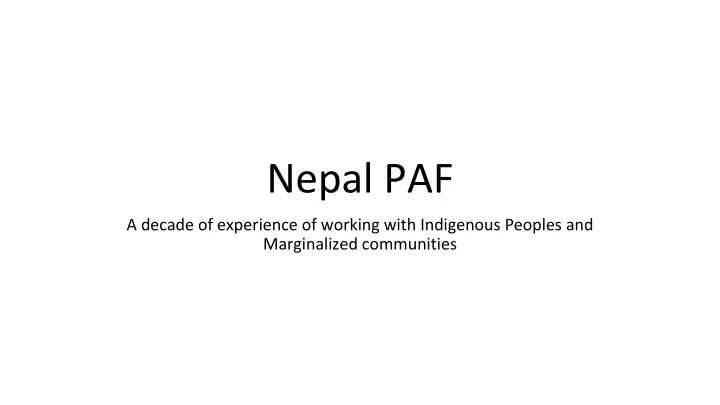

Nepal PAF A decade of experience of working with Indigenous Peoples and Marginalized communities
Nepal's Indigenous People • The 2011 census of Nepal recorded the presence of 125 caste and ethnic groups, 123 languages spoken as mother tongue, and 10 different types of religious groups. • The indigenous peoples (known as Adivasi-Janajatis ) comprise about 30 % of the population. • Social exclusion of IPs , along with other marginalized groups, has been recognized as a major cause of conflict and instability in the country; • One in every four poor is a Hill Janajati (according to NLSS 2011); • Low level of political representation, compared to proportion of their population on legislature, local bodies. • They have been lobbying for a secular, federal state system, in which their rights to self determination, ethnic and linguistic autonomy are ensured,
Government Policy • N ew Constitution in 2015 • Right to equality, and special provisions by law for their protection, empowerment and advancement • Right to language and culture, including its preservation and promotion • Right to social justice, especially in matters relating to education, health, employment, social security, empowerment and development • Proportionate representation in central , provincial and village assemblies • Establishment of a ‘National inclusion Commission’ and ‘Adivasi Janajati Commission’ to be established at the provincial levels to assess and monitor the situation of IPs and accordingly make policy and programmatic recommendations
Snapshot: Nepal Poverty Alleviation Fund • Objective: To improve living conditions, livelihoods and empowerment among the rural poor, with particular attention to groups that have traditionally been excluded by reasons of gender, ethnicity, caste and location. • Originally established in 2003, PAF Nepal has been governed by the Poverty Alleviation Act since 2006. • 55 districts out of 75 • 25,139 Community Organizations (CO) established. (20-25 hh) • Direct beneficiaries: 716,385 households • Direct Funding to COs; (Income Generation or/and Community Infra)
Achievements Social Inclusion • CO member households constitute 25 percent Dalit, 27 percent Janajati, 3 percent Muslim, as well as other castes and social groups who fall under the category of poor and ultra-poor • About 74 percent of CO members are female. • Key positions (President, Treasurer, Secretary) : 32 % Dalit, 30 % Janjati, 3 % Muslim, 26 % Brahman/Chettri, 9 % are others. Poverty reduction - Impact assessment (2007-2014) • Poverty head count rate decreased by 17.4% • The decreased rate is higher for Janjati and Dalit by 18.5 % • Average per capita consumption was increased by 124.2%. The incremental rate is higher in Janajati which is 166.7 %.
How PAF has ensured to involve IPs? Design and Implementation Stage
Design stage • Consultation A series of consultative meetings were held with key stakeholders from the government, NGOs, civil society, community groups, and the private sector to inform the design of PAF. • Rigorous social assessment and analytical work District-level socio-economic assessments were conducted. In partnership with DFID , an analytical paper was published on social inclusion, Unequal Citizens: Gender, Caste and Ethnic Exclusion in Nepal . • VCDP and Indigenous People Planning Framework Vulnerable Community Development Plan (VCDP) to incorporate issues and concerns of indigenous peoples and other vulnerable groups .
Implementation Stage Rigorous Targeting • District: Composite Index of 28 different Social and Economic indicators. • Villages (VDC): Higher weight for Vulnerable Community Specific Composite index (70 %), to ensure to include VDCs having population of IPs and other vulnerable community population. • Household: Community Participatory Targeting Working closely with local Partner Organizations (POs) • Social Mobilizers are often coming from the local communities and they speak the local language and know the local norms and concerns Routine Process Monitoring • PAF staff verify whether the targeting and selection are being followed by the POs and COs. When necessary, agree with them on the measures to improve the delivery and enhance equity and inclusion
Implementation Stage Special programs for inclusion of the marginalized(innovation window) • PAF sets aside some fund for “innovation window” to address the needs of the special target groups who are most marginalized, but not in the PAF’s targeted districts/VDCs and are in the so-called special poverty pocket area. • This arrangement gives some flexibility for PAF to address the dire need of the margined communities which came up at the time of implementation Special support for non-farm income generation activities • JSDF-supported project to enhance livelihood opportunities and to link the rural artisans with the higher-end markets for cultural industries. These are communities which are among the poorest, often landless (including the IPs), but are traditionally known for their rich cultural heritage.
PAF Community Organization (CO) members involved in traditional Dhaka weaving participate in a discussion at Ramechhap district
Challenges and the way forward • Further effort to support the extremely marginalized communities • Strengthening coordination with local authorities VDC and DDCs • Sustainability of Community Organizations • New constitution, federalism and current unrest in terai area
Thank You!
Recommend
More recommend